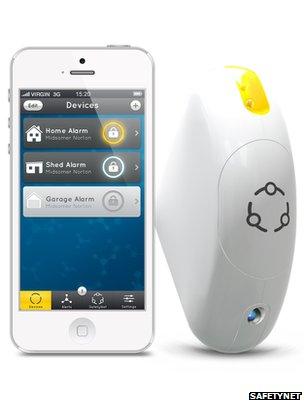New tech helps drivers avoid bikes by using audio alert
- Published
BBC Click's Lara Lewington tests out the new technology which alerts drivers to cyclists
Some of the newest and most innovative technology being developed in the UK is coming from companies who are being supported by a partnership of universities.
They are traditionally a place for learning, researching, developing and for some, socialising well in to the early hours. But one group of universities thinks more should be on offer than just an academic curriculum and guidance.
An initiative between Bath, Bristol, Exeter, Sussex and Surrey universities is focusing on enterprise and is helping start-up tech companies gain access to funding.
Three companies currently taking part are developing new and innovative products to answer problems ranging from cycling safety on the roads and security in the home to how to make musical instruments more interesting.
Cycle Eye
Cycle Eye was born out of the Bristol University innovation centre.
The unit is fitted to the outside of a bus on the driver's left hand side. Using radar and camera sensors it identifies whether an object along side the vehicle is a cyclist and gives the driver an audio alert, typically "cyclist left".
The team say technology like this is only used in the military. The system is different to others already on the market, they say, because the detection algorithm allows the device to differentiate between a cyclist and other objects on the side of the road such as lampposts, railings and other vehicles.
"We've developed a very intelligent system using radar and image processing. We can tell what objects are and the system can still identify cyclists in poor visibility and bad conditions," says Mr Hutchinson, chief executive of Fusion Processing, the company which created Cycle Eye.
The device was involved in a trial by Transport for London and over 3 days of testing had a 98.5% success rate at identifying cyclists.
The team hope that after another round of intensive trialling they will go in to production next year.
Kevin Clinton, head of road safety at the Royal Society for the Prevention of Accidents (RoSPA), said: "With technologies of this type, the key thing is to trial them to make sure they work reliably. It's also important to make sure that they do not overload the driver with too many things to check and too many alerts to interpret."
Alphasphere
Liam Lacey, software developer at Alphasphere, explains how the device works
Making music in your bedroom has long been the hobby of creative teenagers. But one music enthusiast had lost inspiration and was growing increasingly frustrated with his MIDI keyboard.
He decided to take it apart. Detaching the cables from the keyboard he attached them to balloons inside disposable coffee cups and the concept for Alphasphere was born.
Adam Place and his team have been part of the Setsquared initiative for two years and now sell the Alphasphere commercially. They hope to find investors willing to spend money helping them grow the company.
"This instrument clearly has the potential to engage people through its very unique look," says Chris Pratt, a teacher of electronic music production at the DBS Music college in Plymouth.
But he doesn't think it spells the end of more conventional instruments just yet.
"I have some concerns about the shape of the instrument making it a little awkward for fast navigation when performing solo, I don't think I would be able to play the instrument as dextrously as a more traditional keyboard or grid based controllers," he said.
SafetyNet

A prototype design for SafetyNet
Two years ago one of the founders of this company had his house broken in to. After bad experiences with security products already on the market he decided to design his own.
Getting involved with the Setsquared team at Bath University the company started work on SafetyNet - a small, safety alert device that contains a sensor and a camera.
When the sensor detects motion it takes a photograph and a push alert is sent to the owner or anyone they have identified as a first responder.
The team say that the ability to distribute information to the right people at the right time is essential for ensuring a quick response from the police if a crime is being committed.
SafetyNet are at the design and prototype stage of development and hope that a successful link with an investor will allow them to move beyond prototyping and in to production.
Once companies are established they leave the Setsquared initiative to make way for another new UK start-up to gain experience.
So how does Setsquared measure if one of its fledgling tech companies has been successful?
It is all about them using the resources to develop in to a viable business that can thrive outside the confines of the Setsquared environment.
"Attracting grants and funding, trade sales and IPOs are all measures of success," says Graham Harrison, Setsquared's partnership director.
"And churn. We want churn, we don't want people getting comfortable."
Watch BBC Click on BBC One Saturday 0645, BBC News Channel Saturday 0130, 1230, Sunday 1130, 1530 and BBC 2 Monday 1030.
- Published10 December 2013
- Published29 November 2013